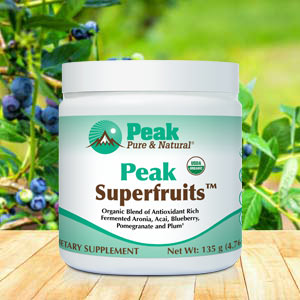Get Easy Health Digest™ in your inbox and don’t miss a thing when you subscribe today. Plus, get the free bonus report, Mother Nature’s Tips, Tricks and Remedies for Cholesterol, Blood Pressure & Blood Sugar as my way of saying welcome to the community!
6 signs of prediabetes and tips that turn it around

According to the National Institute of Diabetes and Digestive and Kidney Diseases, about 84 million adults, or almost 34 percent of adults in the United States, have prediabetes.
That means 34 percent of adults at any given time are poised to cross a threshold that would take them down a chronic disease path. Sounds daunting, doesn’t it?
But what if I told you they could take matters into their own hands and turn that trajectory completely around? Because it’s called prediabetes for a reason…
Put simply, when your fasting blood sugar levels are higher than normal, but not high enough for a diagnosis of diabetes, you’re considered prediabetic. It’s sometimes also called impaired fasting glucose or impaired glucose tolerance.
But the name “prediabetes” may be misleading. You may think, “Oh, my blood sugar isn’t that high yet.”
With every blood sugar spike, the body’s normal insulin response is impaired. If you don’t do something about it, you will end up with full-blown diabetes, and it won’t take long. Then, your whole life will change… and could include strict dieting, cardio complications, medication and possibly daily insulin injections.
So how can you tell if you have prediabetes? And more importantly, what should you do to keep it from progressing to true diabetes?
Risk factors for prediabetes
Prediabetes is diagnosed when fasting blood sugar levels range from 100 to 125 mg/dl (milligrams per deciliter), or when hemoglobin A1C levels range from 5.7 to 6.4 percent (an HbA1c test measures your average blood glucose levels over several months).
You’re at greater risk for prediabetes if you:
- have a family history of diabetes. Your risk increases if a parent or sibling has type 2 diabetes.
- are black, Hispanic, American Indian and Asian-American.
- have high blood pressure. Having blood pressure over 140/90 is linked to an increased risk of type 2 diabetes.
- are not active. Physical activity helps you control your weight, uses up glucose as energy and makes your cells more sensitive to insulin.
- have polycystic ovary syndrome. For women, having polycystic ovary syndrome — a common condition characterized by irregular menstrual periods, excess hair growth and obesity — increases the risk of diabetes.
6 signs to watch for
If the skin on the back of your neck, armpits, knuckles and groin have darkened more than other parts of your body (a condition called acanthosis nigricans), it’s a warning sign of insulin resistance and prediabetes. Armpits, knees, elbows and knuckles may darken as well.
Beyond this frequent first warning sign, there are five others to watch for:
- Blurry vision
- Excessive thirst
- Extreme fatigue
- Frequent urination
- Difficulty sleeping or chronic insomnia
Of course, the only way to know for sure if you have prediabetes, or if you’ve already crossed the line into diabetes, is with a blood test.
The Fasting Blood Sugar test tells you how much sugar is still floating in your blood after you’ve fasted for 12 hours, while the Hemoglobin A1c (HbA1c) test gives you an average blood sugar level over several months.
What you can do now
The good news is that you have a lot of control over whether you develop prediabetes or whether prediabetes becomes full-blown of diabetes.
For starters, you will be able to process insulin more efficiently if you maintain a healthy weight. Exercising regularly and not smoking can also help… and they are good for your heart as well.
Diabetes and high blood pressure are part of metabolic syndrome. Controlling this syndrome with diet and lifestyle will help keep blood sugar within normal limits.
Nutritionist Sheryl Lozicki offers six dietary guidelines to help fight off prediabetes.
- Drink a cup of water with meals and a cup between meals. This fills you up and helps you feel full faster.
- Eat whole fruit for more fiber and avoid fruit juice, soda, imitation juice drinks, sports drinks and energy drinks. Sugar spikes lead to insulin resistance.
- Keep cut-up fruits and vegetables up-front and available on the main shelf of your refrigerator as well.
- Write down what you eat and why. Were you hungry, angry, lonely, etc.? Know which triggers cause you to eat or overeat.
- Increase fiber in your diet to help lower blood sugar. Inulin fiber is considered a natural appetite suppressant that fights fat and diabetes. It’s been shown to improve blood sugar control for women with type 2 diabetes and, in a study on people with prediabetes, subjects on inulin had a 7.6 percent decrease in body weight, while those not taking inulin lost only 4.9 percent.
Editor’s note: Did you know that when you take your body from acid to alkaline you can boost your energy, lose weight, soothe digestion, avoid illness and achieve wellness? Click here to discover The Alkaline Secret to Ultimate Vitality and revive your life today!
Sources:
- Pre diabetes diet plan — sepalika.com
- Diabetes statistics — NIDDKD
- Prediabetes – Know the Symptoms, Signs, Risks, Causes & Lifestyle Changes — sepalika.com
- 15+ silent signs you might be prediabetic — Easy Health Options














